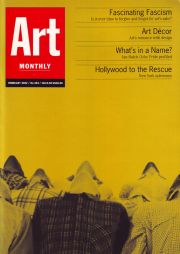Feature
Fascinating Fascism?
Barbara Pollack finds she is still not ready to forgive and forget for art’s sake

Collier Schorr, Herbert, Duty, Siebenbürgen, 2001
Prior to September 11, Evil had taken a beating in post-Cold War America. Co-opted by the entertainment industry, dictators and autocrats were reduced to characters in videogames and war became a backdrop for action flicks and Hollywood tearjerkers. When right-wing politicians and religious leaders used the ‘E’ word, it was most often directed at that great big terror - contemporary art! And artists, in response, decided that Evil was good, especially when it delivered superior kitsch, fashion statements and Broadway hits like Springtime for Hitler.
In this spirit, a mini-army of artists has surfaced which is pillaging Nazi Germany as a treasure trove of 20th-century iconography. While the Holocaust has for some time been a vital subject in contemporary art - artists as diverse as Christian Boltanski, Hans Haacke and Anselm Kiefer have all addressed it - the new trend appears to eschew identification with victims in favour of the appropriation of the aesthetics of power. A show at the Jewish Museum, New York, entitled ‘Mirroring Evil: Nazi Imagery/Recent Art’, is already planned to open in March, featuring Mat Collishaw, Tom Sachs, Christine Borland and ten other artists who exploit and explore Third Reich style. The exhibition questions whether even now, two or three generations after the Second World War, such volatile images can be safely returned to the realm of mere representation - a question originally anticipated by Susan Sontag in her ground-breaking essay ‘Fascinating Fascism’, originally published in the New York Review of Books in 1975. Sontag sensed that the tantalising glamour of Nazi propaganda, calculated to mesmerise the crowds in Germany in the 1930s, would similarly attract image-hungry Pop artists. But she doubted whether Adolf Hitler would ever find equal Pop art status with the likes of Mao Tse Tung and Marilyn Monroe.
As if to test Sontag’s theory, three more shows arrived in New York this Autumn, featuring the Führer and SS aesthetics. All of these shows were planned well before the attacks on the World Trade Center. In other circumstances, they might have been dismissed as schlocky-shock, an accidental synchronicity of bad taste. But, in the aftermath of the WTC tragedy, they have been interpreted as a cultural response to the new face of Evil.
Schlock and shock were most apparent at the installation by David MacDermott & Peter MacGough at American Fine Arts. This artistic duo, who have lived for two decades as 19th-century dandies as an ongoing performance art piece, normally create Victorian-inspired exhibitions employing ante-dated photographic techniques and an Oscar Wilde-like approach to homosexuality. Here, in their first exhibition in New York in a decade, they have finally discovered the 20th Century, a shock in comparison to their previous exhibitions, made all the more shocking by the exhibition’s seeming glorification of fascinating fascism.
For MacDermott & MacGough, shock itself is old fashioned, a relic of past eras, before the atrocities of the 20th century made us allegedly older and wiser. Filled with pink triangles, gold stars and swastikas, this installation taunted viewers to be shocked, not by its ostensible critique of the treatment of homosexuals under the Third Reich, but by the wholehearted adoption in Tom of Finland circles of fascist paraphernalia for their sado-masochistic appeal. Celebrity-style portraits of Adolf Hitler, painted as if by a school of adoring amateur artists, covered one wall of the gallery with an array of Third Reich masculinity. Here, however, each work was inscribed with biographical details of homosexuals exterminated in concentration camps, written in a florid scrawl that the artists discovered was ruled illegal (apparently too feminine) by the Nazis. Across the room, pink triangles and yellow stars (symbols that homosexuals and Jews were forced to wear by the Nazis) formed a decorative pattern on a banner-sized canvas whilst a swastika-covered table in the centre of the room held three vitrines of broken glass in a pathetic evocation of Kristillnacht. A sign at the gallery door featuring Hebrew letters was, according to the artists, a Kabbalistic anagram made from the words ‘Hitler/Evil/Enemy’. I was offended, not by MacDermott & MacGough’s investigation of their own love-hate relationship with this material, but by the artists’ appropriation of my own cultural heritage. My only comfort was the realisation that after witnessing so many shock tactics employed by contemporary artists I was not completely numb to the power of symbols, even 50 years after the Holocaust.
The convergence of Third Reich uniforms and homoerotic masculinity was also on view at Collier Schorr’s ‘Forest and Fields’ at 303 Gallery, an exhibition that raised even more troubling questions about history, photography and the impossibility of remaining neutral. Schorr has been photographing young men in uniforms for several years, often blurring distinctions between portraiture, fashion and documentary photography. Ever treading a razor-sharp edge between fact and fiction, here she invited her subjects, young military-age Germans, to pose in uniforms - some present-day NATO wear, some Nazi-era garb. The pictures are complex and raise complicated feelings: do we feel protective of these gentle youths about to go off to war or are we repulsed by their cultural culpability? The project is complicated further by the fact that Schorr, who is Jewish and gay, does not photograph from the point of view of a victim or an interloper. Instead, her images look as if a young Leni Reifenstahl stood behind the camera, enthralled with these hunky guys clad in Nazi uniforms.
The front room of the gallery showed a series of small black-and-white photographs, appropriating the look of vintage prints or movie stills of the era. Young men bearing guns and at rest in the woods appear to be comfortably posing for a snapshot to send home to their families, circa 1940. In contrast, the large-scale colour photographs that fill the rest of the gallery are imbued with a romantic, yet ahistorical, immediacy. These pictures ‘capture’ the sol-diers, as they bask in a preternatural golden sunlight or lounge in verdant fields, too beautiful to be documentary. The boys themselves are beautiful, too, but it is difficult to appreciate them, given the larger historical context. In Steffen Caught, Barbarossastrasse, the young man’s smooth back fills the frame, his hands clasped behind his head. It is an erotic image, and Schorr has trapped me into desire and sympathy for the apparent prisoner. On the other hand, the image of a teenager clad in Luftwaffe regalia, Andreas POW, and its subtitle, Every Good Soldier was a Prisoner of War, angers me. I guess I still am not ready to forgive and forget.
Identification with Nazi mentality is the subject of Marsha Pels’s installation The Hitler Vitrines, shown at Schroeder-Romero Gallery, a new space in Williamsburg, Brooklyn. Here, Pels appropriated not only Nazi imagery, but also Beuysian art strategies. In the photograph, I Like Germany and Germany Likes Me, the artist poses as the Führer himself, a direct reference to Joseph Beuys’s 1974 performance as well as an early work by Anselm Kiefer. In effect asking ‘who owns history?’, Pels also adapts Beuys’s use of vitrines, presenting a series of cast-crystal forms in glass cases. In one, a glass gas mask is paired with a translucent set of lungs, a reference to the gas chambers. In another, Gestapo boots and a pistol, also glass, converge to form a large-scale totem of Nazi masculinity (again!). A pseudo-cast of Hitler’s one-testicled genitals raises the idea that personal perversion provoked the megalomaniac’s genocidal agenda. In another vitrine a pair of live eels swimming through an aquarium chillingly evokes the glass tanks that held the victims of Nazi medical experiments. Strangely, the vitrines aestheticised the provocative imagery, returning Nazi Germany safely to the halls of history. This strategy diminished the sense of shock, making the exhibition less provocative, but also less thought provoking, than the others.
Whether these exhibitions come to terms with the nature of Evil is not as important as the fact that they show that there are still symbols that can be genuinely provocative and troubling in contemporary art. This is not necessarily good in and of itself; the last thing contemporary art needs is more experiments in shock value. But, in the midst of America’s war against a new form of fundamentalism in the Middle East, this exploration of the ways that symbols can be manipulated by politics (and vice versa) is a history lesson that more Americans need to appreciate. Osama bin Laden (‘Dead Or Alive’) may be the new face of Evil in the US press, but we cannot forget that to Islamic fundamentalists, we (with our skyscrapers, SUVs and liberated women) are the signifiers of immorality.
It is doubtful that bin Laden’s videotapes will prove as influential as the Triumph of the Will or that the Taliban’s turbans will eventually work their way into Western psycho-sexual fantasies. But the streets of New York are already filled with al-Qa’ida’s lasting visual legacy - the thousands of missing posters bearing the faces of those lost at the WTC and the absence of those two towering blocks that once filled the New York skyline.
MacDermott & MacGough were at American Fine Arts at PHAG, New York from November 8 to December 8 2001, Collier Schorr was at 303 Gallery, New York from November 10 to December 21 2001, Marsha Pels was at Schroeder-Romero Gallery, NewYork from November 8 to December 8 2001 and ‘Mirroring Evil: Nazi Imagery/Recent Art’ opened at the Jewish Museum, New York in March 2002.
Barbara Pollack is an artist and writer living in New York.
First published in Art Monthly 253: February 2002.









